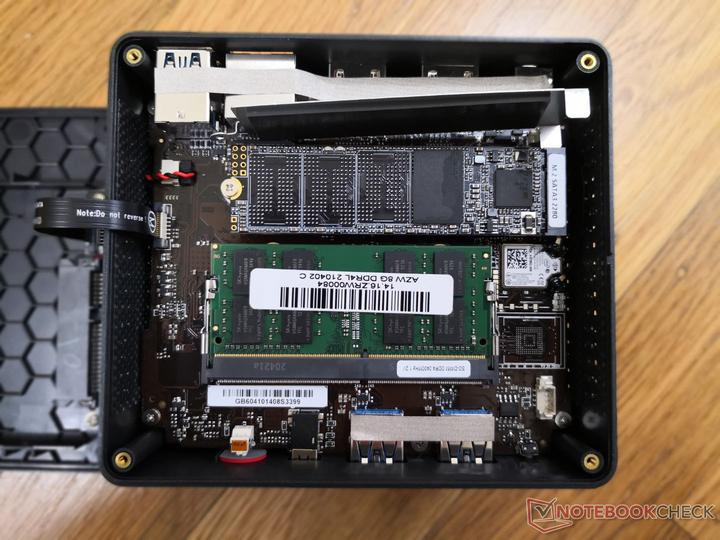Beelink GK Mini
The usual clear benefits to having a compact desktop, especially one that’s practically pocket-size like Beelink’s GK Mini: space savings of course, but also low noise and less cable clutter. Beelink's tiny PC (starts at $299; $319 as tested) is easily hidden behind displays or desks. Even sitting on your desk, it takes up so little space that it's hard to see how it could get in the way. The small size and low, low price present a significant downside, however: Despite having an unusually generous 8GB of RAM, the GK Mini is also markedly sluggish for most tasks. If you’re looking for a solution for digital signage or a low-end system for an information kiosk, the GK Mini is a good, cheap option. But despite the attractive price for a fully configured desktop, a budget laptop will be a better value for most everyday tasks.
Design: Making a Bee-Line for Small
Beelink built the GK Mini with an exceedingly small physical footprint. It measures approximately 4.6 by 4.1 by 1.75 inches, one of the smallest desktops we’ve ever seen that has some user-interchangeable components. Beelink includes a bracket for mounting it on the back of a display.
The system has a single DDR4 SO-DIMM RAM slot and an M.2 Key M slot that gives it some degree of upgradability. Beelink offers the system in different configurations, with the $299 base model at 8GB of RAM and a 128GB SSD; our test unit came with the same DDR4 RAM and a 256GB SATA 3.0 SSD. That's pretty good considering most fully configured desktops this cheap use eMMC memory for storage and top out on the RAM at 4GB.
The exterior of the system is plastic, but it doesn’t flex, and it feels sturdy enough for its intended purpose. For a PC of this size, the GK Mini is relatively easy to upgrade. Most of the system’s internals are reached by removing four screws set in the bottom corners. Once those are extracted, the bottom of the case comes right off.
Underneath, you will have access to one side of the motherboard, which holds a single RAM SO-DIMM (a laptop-style module) and an M.2 slot. That single RAM slot, however, means you won’t be able to run in dual-channel memory mode, and you won’t get much improvement from the upgrade unless you are using more than the 8GB that the system comes with.
Upgrading the system’s SSD is a more viable option, and there’s even room to add a 2.5-inch SSD or hard drive as a secondary drive for additional storage if you need it. The drive mounting bay and the SATA connector are on the lid, connected by a thin ribbon cable.
Connectivity options on the GK Mini are also surprisingly good for a system this size. On the system’s front are two USB 3.0 ports and a headphone jack...
Over on the back of the system are two more USB 3.0 ports, an Ethernet jack, and two HDMI ports. This seems a sensible configuration, as it enables you to have a keyboard, a mouse and two extra USB devices without the need of an adapter. Beelink didn’t disclose which version of HDMI port is used on the GK Mini, but it does support 4K video output on both connections.

As for network connectivity, the Ethernet jack may not be realistic to use with the GK Mini wall-mounted or bracketed to the back of a monitor. The system also supports Wi-Fi 5 (not Wi-Fi 6, forgivable at the price) and Bluetooth.
One somewhat odd inclusion on the system’s exterior is a pinhole "clear CMOS" button. This feature is common on motherboards that support overclocking, as it helps to recover from BIOS-configuration mistakes. It’s also fairly common on lower-end boards in the form of an internal jumper, but it feels a bit out of place to have on the exterior of the GK Mini. (Not that it hurts to include a feature that isn’t strictly necessary.)
Testing the GK Mini: A Celeron Playing Catch-Up
For testing purposes, we put the Beelink GK Mini up against a group of compact PCs that we’ve tested earlier, including ECS’s Liva Q3 Plus and one of Intel’s latest similarly small NUC devices, the NUC 11 Pro Kit. Realistically, the GK Mini isn’t going to win any drag races here; the Intel Celeron J4125 processor at the heart of this system has four CPU cores clocked at 2GHz that are based on Intel’s low-power "Gemini Lake" architecture. It does not support Hyper-Threading. Based on previous experience with Gemini Lake and its predecessor, "Apollo Lake," this is not the stuff of speed.
The other systems in this list employ some variant of Intel’s more powerful Core architecture, except for the ECS Liva Q3 Plus, which has an embedded AMD Ryzen CPU. With that information in mind, it should come as no surprise that the GK Mini trails the pack in all of the following tests, our standard regimen of productivity benches...
These benchmarks are a more reliable gauge of what the GK Mini can and cannot do than simple specs. We would have run a few graphics benchmarks on the GK Mini, too, and presented them here. But we ran into multiple issues on our two basic graphics tests that we weren’t able to resolve. We rely on 3DMark and GFXBench 5.0 for this stage of testing, but neither would work properly on the GK Mini.
GFXBench would install on the system but refused to run even after reinstalling the software multiple times. 3DMark installed without issue and would run the Night Raid and Time Spy trials we use, but for some reason, the software wouldn’t output a 3DMark Overall Score after testing on either one. The software urged updating the graphics driver to get a test score, but after re-installing the latest two Intel integrated graphics drivers with no improvement, we were ultimately forced to give up.
That said, we suspect little loss here, given the Celeron CPU and minimalist Intel UHD Graphics silicon. The GK Mini wasn’t built to run games. (Maybe the system is self-aware enough to know this, and refuses to be judged for its sluggish performance in this area?)
First-Hand Use: To Buy, or Not to Buy
The GK Mini is, in the last six months, the slowest desktop we’ve run through our standard set of benchmarks that we use for modern systems. Even so, the system could still be useful in the right situations. Beelink itself suggests the PC for use in four different areas:
On the last two points, Beelink is quite right. I don’t see anything that makes the GK Mini unfit for use as the engine of an information kiosk. As it has two 4K-ready HDMI ports, the GK Mini is also an excellent option for multi-display digital signage. And though I’d personally prefer something a bit faster for a home theater PC (HTPC), the idea of using the system for that task has merits as well for simple streaming.
As for Beelink’s first two suggestions (about using the GK Mini as a PC for office work or school work), you would be hard-pressed to find a pokier desktop option with modern parts. At $319, the GK Mini comes into competition with low-priced laptops and Chromebooks that will provide a similar or better computing experience. Those systems also have the advantages of being equipped with batteries, keyboards, touch pads, and displays, whereas you might need to buy a bunch of peripherals separately to use the GK Mini as a whole PC. This makes the laptops significantly more cost-effective for that use case.
There’s also the option of buying a refurbished desktop for office or school work. You aren’t likely to find anything quite as small as the GK Mini, but look on Amazon.com or Newegg, and you'll see tons of refurbished and renewed desktop options available under $200 that will provide better performance. Though the space savings are helpful, I personally would dread the idea of working on a system this slow on a regular basis. From a brief search, I was able to find multiple 4th Generation Intel Core i5 desktops that come with a keyboard and mouse for around $100 to $200. I’m sure they would be more pleasing and responsive machines on which to do office work.
Ultimately, you need to weigh how important the space savings are to you with the GK Mini. Unless they are paramount (like it would be, for a digital-signage device meant to be tucked away or hidden), there’s probably a better, bigger, and possibly even cheaper option. It almost feels unfair, in truth, to judge the GK Mini in this way, but as Beelink listed "office PC" and "student PC" as two of the primary roles this device can fill, it's fair to pose the question.
Verdict: Digital Signage? You'll Bee Happy Enough
Though its performance is sluggish and the system is poorly suited for use as a personal or office PC, the Beelink GK Mini still has a silver lining. The system’s extremely small physical footprint and dual HDMI outputs make it well designed for digital signage. It could also perform well enough as an HTPC or in a few other roles that aren’t too taxing. And that price is hard to ignore. Intel's NUC mini systems are much the same size, but try finding one fully configured for just over $300 with 8GB of RAM, a 256GB SSD, and Windows installed. We'll wait right here.
A fair deal of the criticism we leveled against the system comes more from the company’s marketing the PC toward office or school use, as better options abound for those tasks in the same price range. Buy the GK Mini only if you need it for one of those explicit tasks that it is designed for, and you'll be happy enough. Just don't expect it to be (Bee?) a snappy daily driver.








